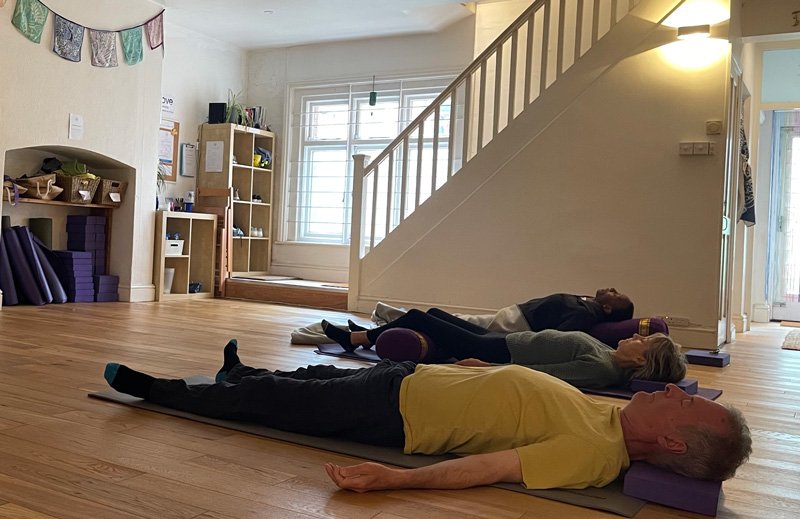
**Yoga as an Effective Method for Controlling Stress and Anxiety: Perspectives from Dr. Sat Bir S. Khalsa**
—
### Comprehending Anxiety and Stress in Contemporary Life
It’s widely acknowledged that stress and anxiety are nearly omnipresent in today’s rapid environment. The demands and uncertainties of daily existence have increased significantly in recent years, and for numerous individuals, the COVID-19 pandemic pushed these issues to a tipping point. Anxiety levels in the U.S. surged over threefold during the second quarter of 2020, climbing from 8.1% in 2019 to 25.5% within a year **[1]**.
Although perceived stress and anxiety can often arise as a typical reaction to difficulties, prolonged stress can severely diminish one’s quality of life. Beyond the emotional consequences, chronic stress disrupts bodily functions, compromising the immune system and making individuals susceptible to further health problems. Managing stress is not just achievable but essential for overall health. Fortunately, a growing body of evidence indicates that mind-body practices such as yoga can significantly contribute to addressing both the physical and emotional aspects of anxiety.
—
### Why Choose Yoga?
Physical activity, breathing exercises, relaxation methods, and meditation are all acknowledged as beneficial tactics for alleviating anxiety. Yoga, a centuries-old practice, harmoniously integrates all these elements into a singular, unified practice. While the health benefits of yoga have been recognized for centuries, only recently have researchers and health professionals begun to investigate and quantify the considerable positive effects yoga can have on mental health.
### Yoga as a Mind-Body Approach for Anxiety Disorders
Anxiety disorders, including generalized anxiety disorder (GAD), interfere with the daily lives of countless individuals, producing a variety of mental and physical symptoms. These symptoms extend beyond heightened worry or difficulties in focusing. They encompass muscle tightness, shaking, perspiration, and sleeplessness, all originating from the activation of the body’s fight-or-flight response. Conventional treatments for anxiety frequently concentrate on the psychological components, such as cognitive behavioral therapy (CBT), or depend on medication. Unfortunately, pharmaceuticals can lead to side effects, and psychotherapy does not always yield results for everyone, potentially falling short of addressing the complex mind-body connection inherent in anxiety disorders.
This is where yoga distinguishes itself. Its distinctive combination of physical poses, regulated breathing, relaxation techniques, and meditation enables yoga to address both the psychological and physical symptoms of anxiety. Through consistent practice, yoga disrupts the automatic responses that exacerbate anxiety, assisting individuals in developing both mental strength and enhanced physical relaxation. Gradually, yoga enhances one’s capacity to manage anxious thoughts, ultimately lowering both their frequency and intensity through improved self-awareness and emotional management.
—
### Empirical Evidence Promoting Yoga’s Role in Anxiety Management
The evidence supporting yoga’s capacity to alleviate anxiety is growing. Meta-analyses—research overviewing the results of multiple clinical trials—have indicated yoga as a potentially effective and safe intervention for individuals grappling with anxiety **[2][3]**. This is further corroborated by studies that demonstrate yoga’s effectiveness in reducing anxiety in children and teens, a crucial finding in light of the increasing mental health issues in younger populations **[4]**.
Much of Dr. Khalsa’s research has concentrated on *Kundalini Yoga*, a form that involves postures, dynamic breathing, deep relaxation, meditation, and mantra usage. His studies suggest that Kundalini Yoga not only enhances physical performance but also supports self-regulation, improves mind-body awareness, and fosters positive mental states. These advantages are particularly significant for individuals dealing with stress-related disorders such as PTSD and GAD.
In one of Dr. Khalsa’s studies, Kundalini Yoga showed promise as a treatment for PTSD **[5]**. Another investigation examined the combination of Kundalini Yoga with CBT, resulting in an approach known as Yoga-enhanced CBT (Y-CBT)—this combination greatly reduced anxiety, depression, and panic, and improved sleep and overall well-being among participants with GAD **[6]**.
Perhaps most remarkably, a large randomized clinical trial published in *JAMA Psychiatry* in 2020 showcased that Kundalini Yoga can serve as an effective treatment alternative for GAD **[8]**. Participants in this research either practiced Kundalini Yoga, engaged in CBT, or received stress-management education over 12 weeks. Although CBT proved more effective in general, Kundalini Yoga still surpassed the stress education approach, suggesting that yoga serves as a valid supplementary option for anxiety treatment.
The cumulative research emphasizes yoga’s remarkable capacity to positively affect both mental and physical health, positioning it as a viable alternative for anxiety disorders. The growing evidence base is exciting as it provides healthcare practitioners and their patients with an additional resource to enhance traditional methods of treatment.
—
### Seizing Control: Practicing Yoga at Home
As research continues to explore yoga’s full potential as an anxiety intervention, it’s important to highlight that yoga does not necessitate any specific equipment or environment.